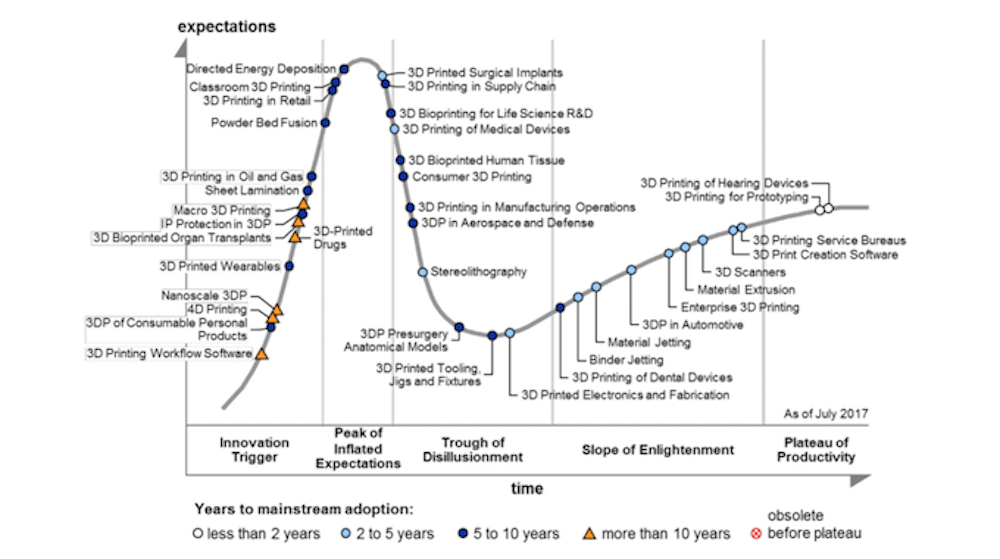
Gartner has once again re-issued their 3D Printing Hype Cycle and it’s fascinating to see how things have progressed.
The Hype Cycle is a concept invented at Gartner that illustrates how a technology proceeds through a series of very distinct “expectation levels” as it matures. They’ve published these reports annual for many years now.
One of the key concepts in the hype cycle is a period they call the “trough of disillusionment”, where a previously super-hyped technology has the market turn on it, as their outrageous expectations were not met. It turns out almost every technology goes through this phase.
What Gartner has done, however, is chopped up “3D printing” into a number of specific applications and planted them on the chart in positions where they feel they’re currently rated.
The item I’m most fascinated with is “Consumer 3D Printing”, which was hyped to the extreme in 2013-2015, whereupon it crashed violently. On Gartner’s chart, it is still headed into the deepest portion of the “trough”. It will take many changes before it emerges from that position, I am afraid, but that’s an issue for another post.
What I want to talk about today is our friend Rachel Park’s words on this report she recently posted on Disruptive.
Rachel described her experience at a recent conference in which speakers (including Gartner) explained that the consumer debacle significantly hurt the industry. She writes:
Dr Phil Reeves of Stratasys Expert Services made just this point at the recent International Conference on Additive Manufacturing & 3D Printing, citing how he believed that mainstream media hype 3-5 years ago damaged the AM industry. He said the promised ‘revolution’ was a misnomer. Dr Reeves’s presentation was centered around barriers to adoption, so his inclusion of the historically inflated press coverage of 3D printing was telling.
He pointed to the much more ‘conservative’ reality of today, where there are some truly great applications, but many more mundane yet business-boosting applications of AM across a plethora of industrial sectors.
I believe this to be true; those who have been observing the situation in a cursory manner would conclude that 3D printing is overrated and might not be worth a look. That’s hurtful to many businesses, large and small, who otherwise might take huge advantage of specific uses of 3D printing.
I suspect small companies without large research departments might be hurt worse, as the larger firms might be in a position to more easily figure out how best to use the technology.
The point I want to make is that this dent was inevitable.
Any new technology, anything that has a whiff of magic to it, will instantly attract all manner of unscrupulous individuals who hope to transform that magic into cash, and quickly. It was those people and their companies that put the industry through these troubles.
But it will happen to every technology. We may be seeing it now with Virtual Reality. We saw it with 3D TVs a few years ago, and where are they now?
Yes, the consumer bust hurts, but it is a stage that an industry must get through to survive and thrive.
And that’s exactly what’s happening.
Via Disruptive

